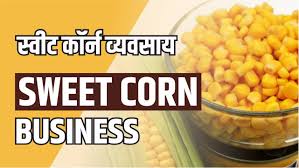With the rising demand for convenience foods, the frozen food industry in India has seen exponential growth — and frozen sweet corn is one of the most popular items in this category. Whether it’s for home use, quick recipes, or use in restaurants, frozen sweet corn is a versatile and in-demand product. Starting a frozen sweet corn processing business can be a highly profitable venture, especially if you focus on quality, hygiene, and proper supply chain management.
Here’s a comprehensive guide to help you launch your own frozen sweet corn business:
1. Market Potential and Industry Outlook
The Indian frozen food market is expected to reach over ₹300 billion by 2025, and frozen vegetables account for a major portion of this growth. Sweet corn is consumed across homes, cafés, food trucks, cinemas, restaurants, and even airline catering services.
Why Sweet Corn?
-
High in demand year-round
-
Easy to process and store
-
Multiple uses – snacks, curries, soups, pizzas, salads
-
Long shelf life and high retail value
2. Business Model Options
You can choose from different models based on your investment and vision:
a. Small-Scale Unit – Target local markets, restaurants, and food trucks.
b. Mid-Scale Unit – Sell under your own brand name through supermarkets and online platforms.
c. B2B Model – Supply to big food processors, hotels, and export companies.
3. Key Steps to Start the Business
Step 1: Conduct a Feasibility Study
-
Analyze demand in your target region
-
Identify competitors and pricing
-
Estimate fixed and variable costs
-
Plan logistics and raw material sourcing
Step 2: Create a Business Plan
A good business plan should include:
-
Executive summary
-
Market analysis
-
Investment & funding sources
-
Marketing & distribution strategy
-
Risk analysis and financial projections
4. Location and Infrastructure
You’ll need a 25,000–50,000 sq. ft. area depending on scale. Look for areas close to:
-
Sweet corn farms (to ensure fresh raw material)
-
Cold chain infrastructure
-
Market or transport hubs
Layout Includes:
-
Raw material storage
-
Processing area
-
Freezing unit
-
Packaging section
-
Cold storage
-
Office and utilities
5. Licenses and Registrations
Starting a food processing business in India requires several legal compliances:
Mandatory Licenses:
-
FSSAI License (Food Safety and Standards Authority of India)
-
Udyam Registration (MSME)
-
GST Registration
-
Factory License (if applicable)
-
Pollution NOC (from SPCB)
-
Fire & Safety Certificate
-
Trademark Registration (if creating a brand)
6. Machinery and Equipment
You’ll need semi-automatic or fully automatic machines based on scale. Key equipment includes:
-
Corn threshers/husk removers
-
Washing and blanching machine
-
Belt conveyor
-
Flash freezing tunnel (IQF – Individual Quick Freezing technology)
-
Packaging machine (vacuum/seal)
-
Weighing machine
-
Cold storage units (-18°C to -22°C)
-
Power backup generator
Estimated equipment cost:
-
Small scale: ₹15–20 lakh
-
Medium scale: ₹50 lakh–₹1 crore
-
Large scale: ₹2–3 crore+
7. Manpower Requirement
A typical team may consist of:
-
Machine operators
-
Skilled workers (washing, blanching, packing)
-
Quality control supervisor
-
Cold storage manager
-
Sales and logistics staff
-
Accountant/Admin staff
Manpower: 10–25 people (depending on automation)
8. Raw Material and Processing
Raw Material:
-
High-quality fresh sweet corn (procured directly from farms or mandis)
Processing Steps:
-
Sorting and husking the raw corn
-
Washing and cleaning
-
Blanching (brief heat treatment)
-
Cutting/Kernel removal
-
Flash Freezing (IQF – ensures kernels don’t stick together)
-
Packaging in vacuum-sealed or nitrogen-filled pouches
-
Cold storage and transportation
Ensure hygiene, temperature monitoring, and FSSAI standards are followed.
9. Packaging and Branding
Attractive and functional packaging is key in the frozen food business.
Tips:
-
Use food-grade, leak-proof, tamper-proof pouches
-
Display nutritional value and FSSAI number
-
Use vibrant colors and offer 200g, 500g, 1kg packs
-
Provide usage tips on packs (e.g., microwave or steam ready)
If targeting retail, register a brand name and build strong packaging identity.
10. Marketing and Sales Channels
Offline Sales
-
Supermarkets (Big Bazaar, Reliance Fresh, etc.)
-
Local Kirana stores
-
Horeca (Hotels, Restaurants, Catering)
-
Cafés, canteens, and multiplexes
Online Sales
-
Create your own website and sell through Amazon, Flipkart, BigBasket, etc.
-
Partner with food delivery apps for bundled meals
Marketing Tips
-
Run ads on Facebook, Instagram & Google
-
Offer samples to chefs and restaurants
-
Highlight nutritional benefits
-
Attend food expos, agri trade fairs, and frozen food exhibitions
11. Investment and Profitability
Approximate Startup Cost:
-
Small Scale: ₹25–30 lakhs
-
Medium Scale: ₹50 lakhs–1 crore
-
Large Scale: ₹2–5 crore
Expenses Include:
-
Machinery and setup
-
Cold storage and transport
-
Raw materials
-
Labor, packaging, marketing
-
Utility bills and maintenance
Profit Margins:
-
Profit per kg: ₹10–₹20
-
Break-even time: 1.5 to 2 years (with proper demand)
12. Government Support and Subsidies
You can benefit from various government schemes:
-
PM Formalisation of Micro Food Processing Enterprises (PM-FME) Scheme: 35% subsidy on capital investment
-
MoFPI – Mega Food Park Scheme
-
NABARD, SIDBI Loans
-
Cold Chain Subsidy Scheme
-
Agri Infrastructure Fund (AIF)
Approach your District Industries Centre (DIC) or KVIC/KVIB for help.
13. Risks and Challenges
-
High electricity cost for cold storage
-
Perishable raw material — needs strong sourcing strategy
-
Cold chain logistics can be expensive
-
Seasonal price fluctuations in corn
Risk can be mitigated by sourcing contracts with farmers, power-efficient freezing tech, and hybrid solar cold storage.
The frozen sweet corn processing business is a high-potential, future-ready opportunity in India’s growing food industry. With a strategic approach to sourcing, production, quality control, and branding, you can build a sustainable and profitable venture. Whether you start small or go large-scale, the key is maintaining hygiene, efficiency, and consistency — and delighting customers with every bite of corn!

